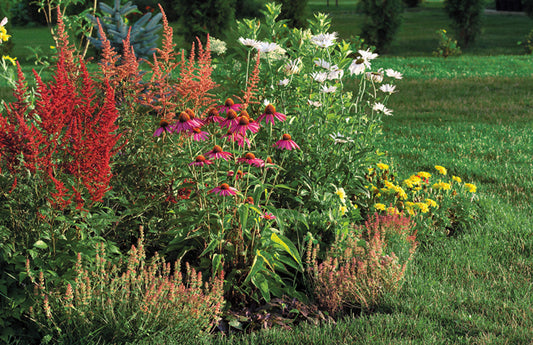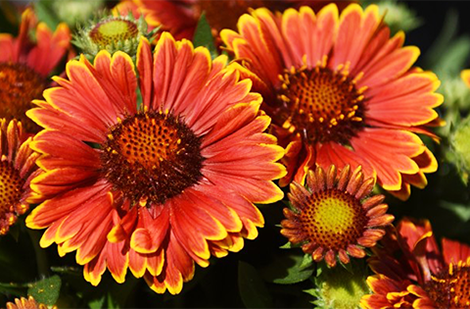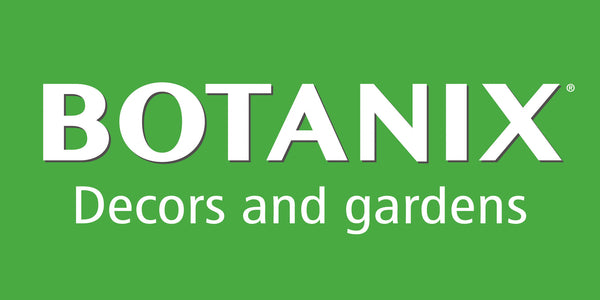Dicentra spectabilis
Old-fashioned Bleeding Heart
Old-fashioned Bleeding Heart
Exposure
- Partial shade
- Shade
Rusticity
Bloom time
- Mai
- June
- July
- Pink and white heart-shaped flowers
- Decorative powdery-green foliage
- Delicate and finely cut leaves
- Ideal for shaded areas
- Adds a pop of colour at the start of the season
Discover the timeless charm of Dicentra spectabilis, a classic perennial that remains an irreplaceable favourite in gardens. Old-fashioned Bleeding Hearts form large, bushy clumps of powdery-green foliage comprised of cut or lobed leaves on fleshy stems. In late spring, elegant chains of puffy heart-shaped flowers with rose-pink petals and white tips dangle gracefully beneath the arching, leafless stems. These racemes make delightful additions to fresh bouquets, lasting about 2 weeks in a vase. In cooler climates with adequate moisture, the bloom time may be extended into early summer.
Characteristics
- Foliage : The foliage of Dicentra spectabilis is a powdery-green, forming large, bushy clumps. The leaves are cut or lobed and are borne on fleshy stems.
- Bloom : In late spring, the plant produces racemes of dangling heart-shaped flowers. The petals are rose-pink with white tips, creating a charming contrast.
- Light : Prefers part shade (4-6 hours of direct sun) to full shade (less than 4 hours of direct sun).
- Habit : Its habit is that of a bushy clump.
- Growth : Its growth rate is rapid.
- Humidity : Requires average to consistent moisture.
- Soil : Thrives in average to fertile soil quality, with acidic (pH < 7.0), neutral (pH = 7.0), or alkaline (pH > 7.0) soil chemistry.
- Temperature : Very hardy, tolerating hardiness zones 3 through 9, which includes the Canadian climate.
- Watering : Requires average to consistent watering. It's important to keep the soil evenly moist, especially in the spring during blooming.
Uses
- Types of Use : Ideal for borders, flower beds, rock gardens, cottage gardens, or woodland shade gardens. Also suitable for growing in containers on patios and produces excellent cut flowers for bouquets.
- Decorative Advantages : Its unique heart-shaped flowers and attractive foliage make it a charming focal point in the spring garden. It attracts hummingbirds and is bee-friendly.
Care
- Fertilization : A light fertilization in the spring can promote healthy growth. Use a balanced perennial fertilizer.
- Pruning : After the spectacular bloom, Old-fashioned Bleeding Hearts usually go dormant until the following spring. The foliage may turn yellow and disappear. You can cut back faded foliage for aesthetic reasons.
- Planting :
- Distance : Space plants 75 to 90 cm (30 to 36 inches) apart to allow for good air circulation and optimal growth.
- Depth : Plant the crown (the part where the stems meet the roots) just at the soil surface level.
- Period : Fall or early spring are the best times for planting.
Also known as Mary's Heart or Jeannette's Heart. (Lamprocapnos spectabilis)
Plant details
Dimensions
Dimensions
Characteristics
Characteristics
Habit:
- Bushy
Flowering colours:
- Pink
Plant needs
Plant needs
Watering:
- Moderate
Maintenance:
- Easy. Cut off dead stems in spring.
Soil requirement:
- Well-drained and humus-rich
Features
Features
Resistance:
- White-tailed deer
- Rabbits
- Drought
Attract:
- Bees
- Butterflies
- Hummingbirds
Use:
- Beds
- Shaded areas
- Flowerbed
- Border
Attribute:
- Early Blooming
- Cut Flower
- Easy to Grow
Related articles
-

Perennials for all occasions
Read the articleOsez créer des associations inédites qui sauront refléter votre personnalité, même si pour cela vous deviez déplacer certaines vivaces pour mieux les mettre en valeur.
-

Landscaping with perennials
Read the articleVariétés à découvrir, la tomate se savoure crue, en sandwich, en bruschetta ou en salade. Cuite, c'est l'ingrédient de base de sauces, soupes et salsas.
-

Perennials proper maintenance: cut and fertilize
Read the articleLa grande popularité des vivaces vient du fait qu'après avoir été oubliées pendant des mois au cours de l'hiver, elles réapparaissent sur la scène plus énergiques et surprenantes que par...
-

How to plant perennials in your garden
Read the articleEn pénétrant au jardin, ce sont souvent les plantes vivaces que l’on remarque en premier. Un massif de sauges, d’hémérocalles, d’astilbes, d’échinacées ou de lavande offre un spectacle d’une beauté...














